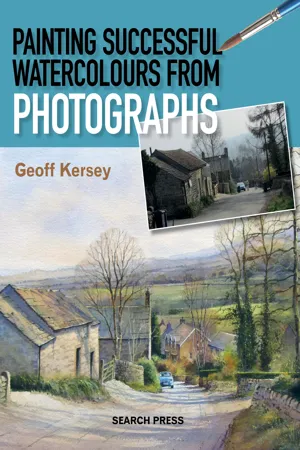
- 128 pages
- English
- ePUB (mobile friendly)
- Available on iOS & Android
eBook - ePub
Painting Successful Watercolours from Photographs
About this book
Learn the essential techniques for painting from photographs with this illustrated guide by the acclaimed artist and teacher.
Many artists enjoy using photographic reference material, but while there are many advantages to this way of working, there are also unique challenges. One must learn to choose what to leave out, what to keep in, and how to adapt the scene to create a painting. In this book, Geoff Kersey introduces twenty-seven of his own paintings, explaining how they evolved from one or more photographs.
Kersey includes photographs, sketches, diagrams, details, colour charts and a wealth of tips explaining his techniques and artistic process. This volume also includes a glossary of painting terms as well as photographs for readers to interpret for themselves.
Many artists enjoy using photographic reference material, but while there are many advantages to this way of working, there are also unique challenges. One must learn to choose what to leave out, what to keep in, and how to adapt the scene to create a painting. In this book, Geoff Kersey introduces twenty-seven of his own paintings, explaining how they evolved from one or more photographs.
Kersey includes photographs, sketches, diagrams, details, colour charts and a wealth of tips explaining his techniques and artistic process. This volume also includes a glossary of painting terms as well as photographs for readers to interpret for themselves.
Frequently asked questions
Yes, you can cancel anytime from the Subscription tab in your account settings on the Perlego website. Your subscription will stay active until the end of your current billing period. Learn how to cancel your subscription.
No, books cannot be downloaded as external files, such as PDFs, for use outside of Perlego. However, you can download books within the Perlego app for offline reading on mobile or tablet. Learn more here.
Perlego offers two plans: Essential and Complete
- Essential is ideal for learners and professionals who enjoy exploring a wide range of subjects. Access the Essential Library with 800,000+ trusted titles and best-sellers across business, personal growth, and the humanities. Includes unlimited reading time and Standard Read Aloud voice.
- Complete: Perfect for advanced learners and researchers needing full, unrestricted access. Unlock 1.4M+ books across hundreds of subjects, including academic and specialized titles. The Complete Plan also includes advanced features like Premium Read Aloud and Research Assistant.
We are an online textbook subscription service, where you can get access to an entire online library for less than the price of a single book per month. With over 1 million books across 1000+ topics, we’ve got you covered! Learn more here.
Look out for the read-aloud symbol on your next book to see if you can listen to it. The read-aloud tool reads text aloud for you, highlighting the text as it is being read. You can pause it, speed it up and slow it down. Learn more here.
Yes! You can use the Perlego app on both iOS or Android devices to read anytime, anywhere — even offline. Perfect for commutes or when you’re on the go.
Please note we cannot support devices running on iOS 13 and Android 7 or earlier. Learn more about using the app.
Please note we cannot support devices running on iOS 13 and Android 7 or earlier. Learn more about using the app.
Yes, you can access Painting Successful Watercolours from Photographs by Geoff Kersey in PDF and/or ePUB format, as well as other popular books in Art & Art General. We have over one million books available in our catalogue for you to explore.
Information
Painting techniques
Fading colour
The idea here is to fade the distant hills, keeping the clearly defined shape but softening its appearance and at the same time slightly reducing the strength of the colour. The sky and hills must be completely dry before you start. Lightly brush over the top of the hill with clean water before dabbing with a clean tissue (see below). This one attempt may well be enough, but if you wish to fade it further, repeat the exercise. If you brush too vigorously, you are in danger of removing some of the sky as well, which would be very difficult to paint back in.
This effect is much easier to achieve on a good quality cotton-based paper, as it is harder to remove colour once it has dried. Generally on cheaper, wood pulp-based papers, where the colour sits on top, it is all too easy to remove too much, wiping out the hill and sky in one go.
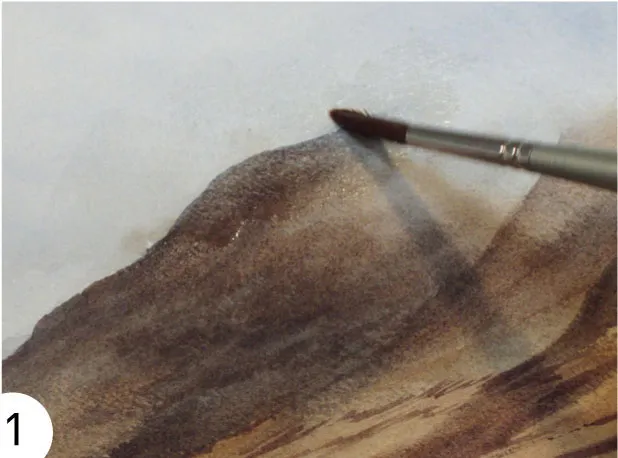

Mist and low cloud on hills
Trying to achieve what artists call the ‘lost and found’ effect of the mist-shrouded hills and shoreline can be tricky, but it is also quite exciting if you get it right. You need to paint the sky first and ensure it is completely dry, before commencing this stage. The key to this method is to keep brushing in clean water as you paint the hills, giving the impression that you are glimpsing the hills through the moving veil of mist and low cloud. In other words, you don’t so much paint the mist and cloud as use the clear water to reveal the cloudy sky that is already there on your paper from the previous stage. Practise on a smaller scale first, perhaps with a few thumbnails before applying it to your painting. In the example shown here, you can see that I used the same mixtures of grey and blue that I had used in the sky to render the hills, so that they became part of the background.
Do try not to overwork this effect, or you will lose the feeling of light, and dabbing into drying paint can cause ‘cauliflowers’ or runbacks.


Applying masking fluid to a wet background
This is an effect I often use when I want to create a soft shape with the masking fluid rather than a hard-edged shape. It is particularly useful when you wish to mask out an area like a bush or tree or even an area of weeds, wild flowers or grasses.
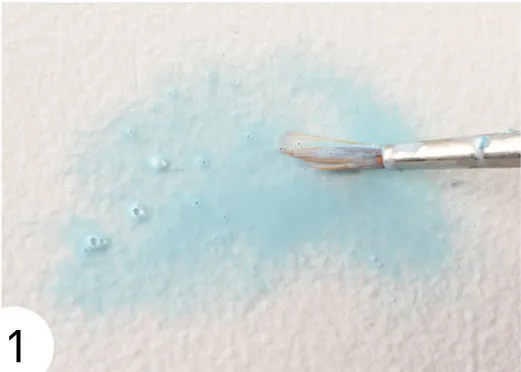
1 Wet the paper, then float in the masking fluid to create a soft-edged shape for a bush. Allow it to dry.

2 Wet the background again and float in cobalt blue for the sky, then aureolin and cobalt blue around the masked bush.
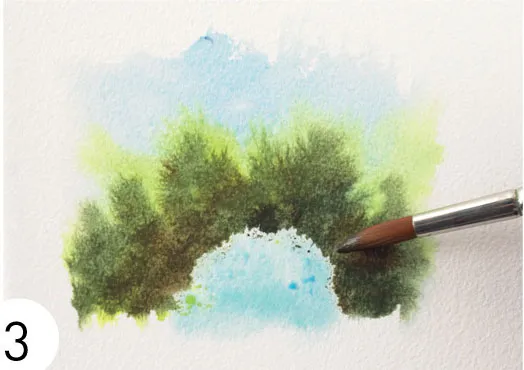
3 Drop in a mix of ultramarine, aureolin and burnt sienna to create a dark contrast with the bush. Allow to dry.

4 Rub off the masking fluid. Drop in lemon yellow, then aureolin and cobalt blue, then aureolin, ultramarine and burnt sienna.

5 Pick out a few leaf shapes using neat lemon yellow and a fine brush.
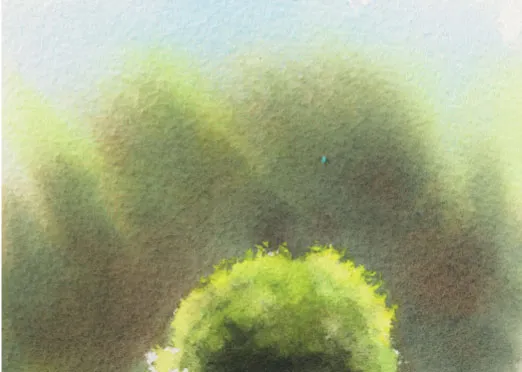
The finished bush.
A view through an opening
In a situation like this it is important that the view through the opening appears to be part of the background. In order to achieve this, it is important to paint what you see through the opening at the same time as you paint the background; but how do you avoid getting paint on the stonework?
You can see in this example, taken from the Ruined Mill painting (page 46), that once I had drawn the stone arch and surround, I masked out the shape with masking fluid; taking care to apply it generously so that no stray green paint landed on the stonework. After the masking fluid had dried, I painted into the wet background, and once the background had dried, I removed the masking fluid, leaving a crisp, white image in the shape of the stonework.
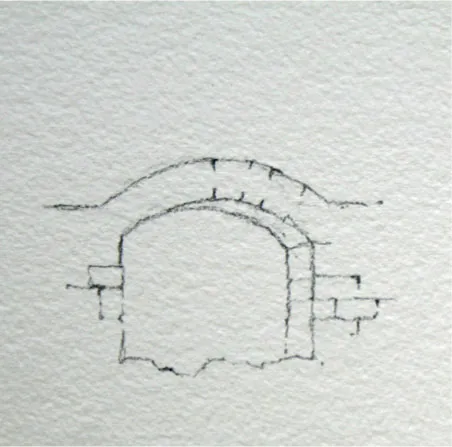
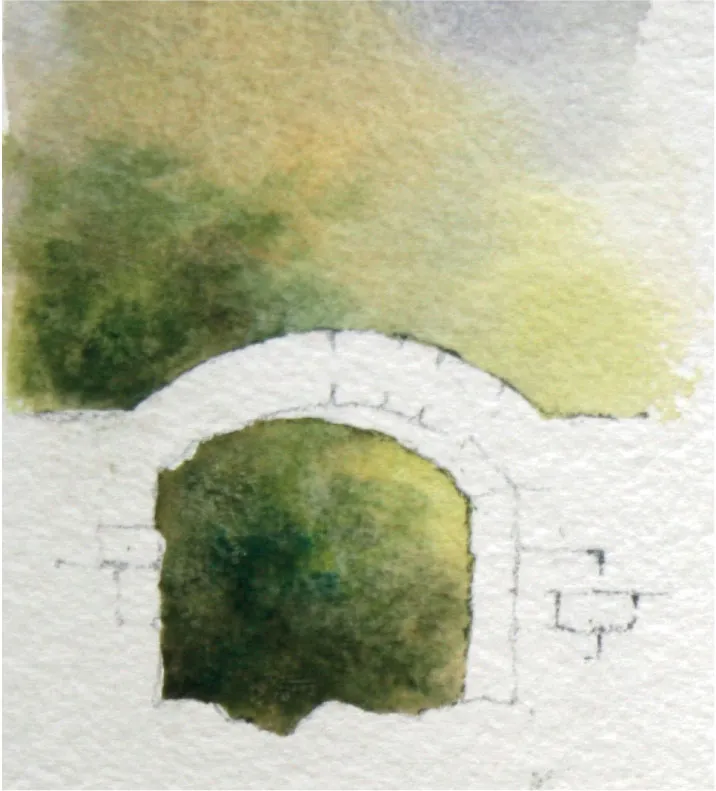
Textured, blotchy bark
This method can also be used for silver birch trees and various other textured surfaces. It can be a bit hit and miss, so practice should pay dividends. It was used for the plane tree in the Mediterranean Street Café painting on pages 76–79.
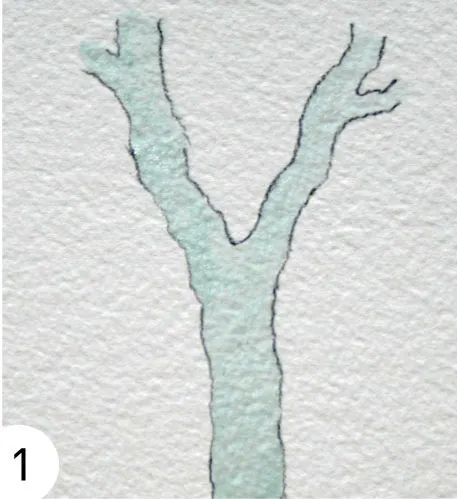
1 Draw the tree trunk in pencil, and then mask it completely with masking fluid.
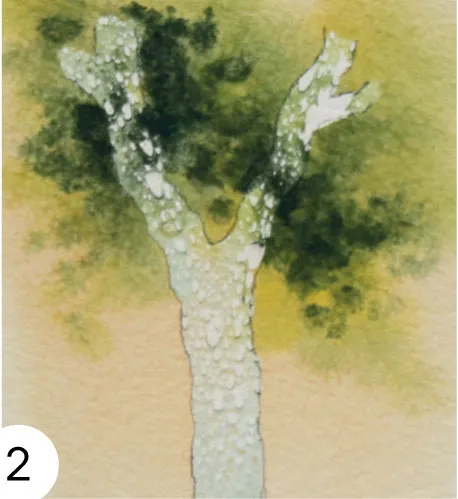
2 Paint in the background with a thin wash of raw sienna, followed by a light and dark green to represent the foliage. Once this has dried, rub the masking fluid with the tip of your finger, taking care to only partially remove it.
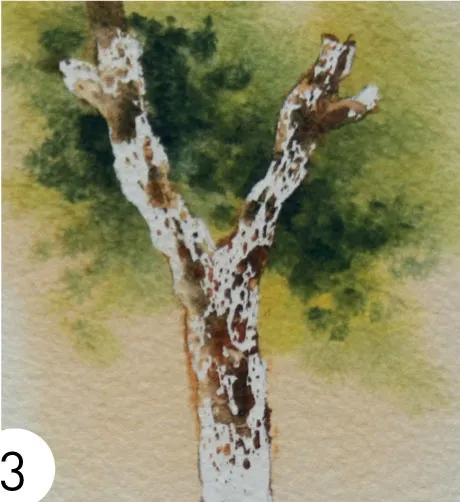
3 Paint some raw sienna and dark brown on to the now partially masked tree trunk, giving the blotchy, uneven effect. This can then be repeated by removing a bit more masking fluid and brushing in a bit more colour.
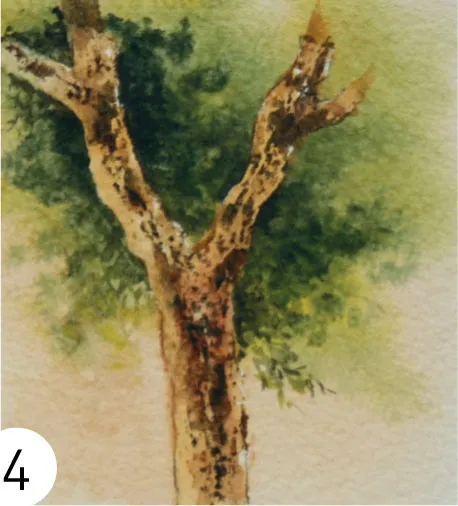
4 When you have finally removed all the remaining masking fluid, add a touch more raw sienna to take the whiteness off.
Using flat brushes
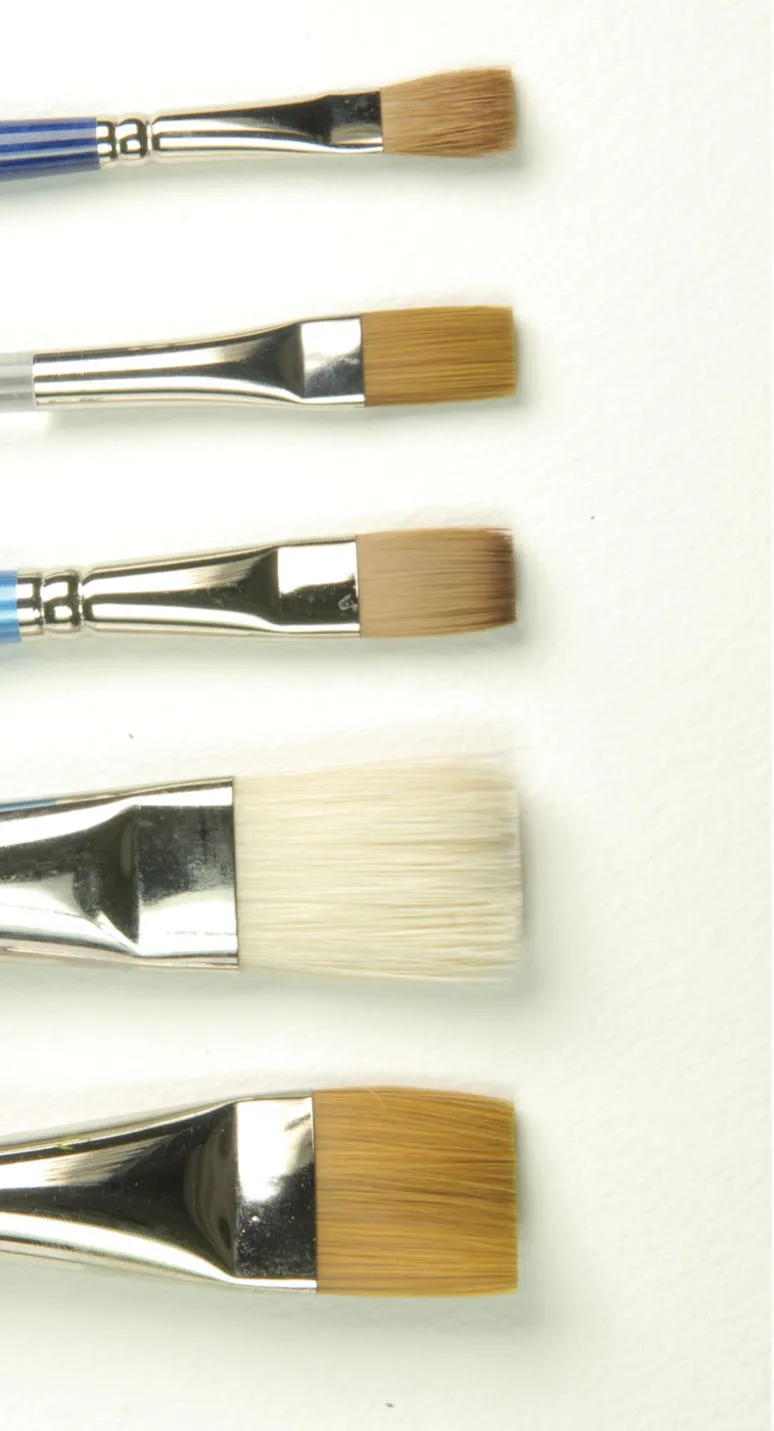
A simple way to do windows, especially when there are a lot of them, is to use a small flat brush, sometimes referred to as ‘one-stroke’ brush. I have in my collection several of these brushes: no. 2, 4, 6, and 10, to give me a variety of widths to choose from, depending on the size of the painting and building. This not only speeds up the process, it also helps to make all the windows consistent in shape and size. It also makes it easier to avoid the rounded corners you can sometimes get with a round brush.
You can see from the picture that before painting the shapes, I put in a pencil grid to keep the windows roughly in line. Even in an old, weathered building, the windows line up, but this is particularly important in formal buildings like Chatsworth House, shown on page 67, or apartment blocks as in the painting of Vernazza on page 55. It is important to put in these pencil guidelines after you have painted the background colours, as it is then easy to rub them out after the window shapes have been painted. It is always worth remembering that once you paint over pencil lines, even w...
Table of contents
- Cover
- About the Author
- Title
- Copyright
- Dedication
- Contents
- Introduction
- Materials
- Painting techniques
- Over to you
- Glossary